Brownstone Research Proudly Presents
Will you be blindsided by…
“THE TECH SHOCK”
Dormant for over two decades… it’s returned. And it’s coming for us all.
Never seen anything like it” – Elon Musk
“Our top and immediate priority” – The White House
“This is a Six Sigma event … a Black Swan” – Major Tech CEO
Table of Contents:
- One of The Most Trusted Tech Voices in America
- The World Is Going “Crazy”
- Introducing: The “Tech Shock”
- The Real Truth About The Computer Chip Shortage
- What’s Likely Coming Next
- Step 1. The “Tech Shock” Portfolio
- Step 2. The Companies to Stay Away From
- Step 3. Profit from the “Stay Home” Surge
Watch the Video Here
HOST: Soaring prices…
Mass shortages…
What’s next?

Hi, Chris Hurt here.
If you’re like most people, you may have noticed some… strange things… popping up in the news lately.
Once again, the word “Crisis” is being thrown around.

But this is unlike anything we’ve seen before…
Major automakers – from GM to Toyota are shutting their factories.

Analysts are warning … Christmas, as we know it, may not happen this year.

And massive food distributor, Sysco, says it’s going to have trouble stocking grocery store shelves.
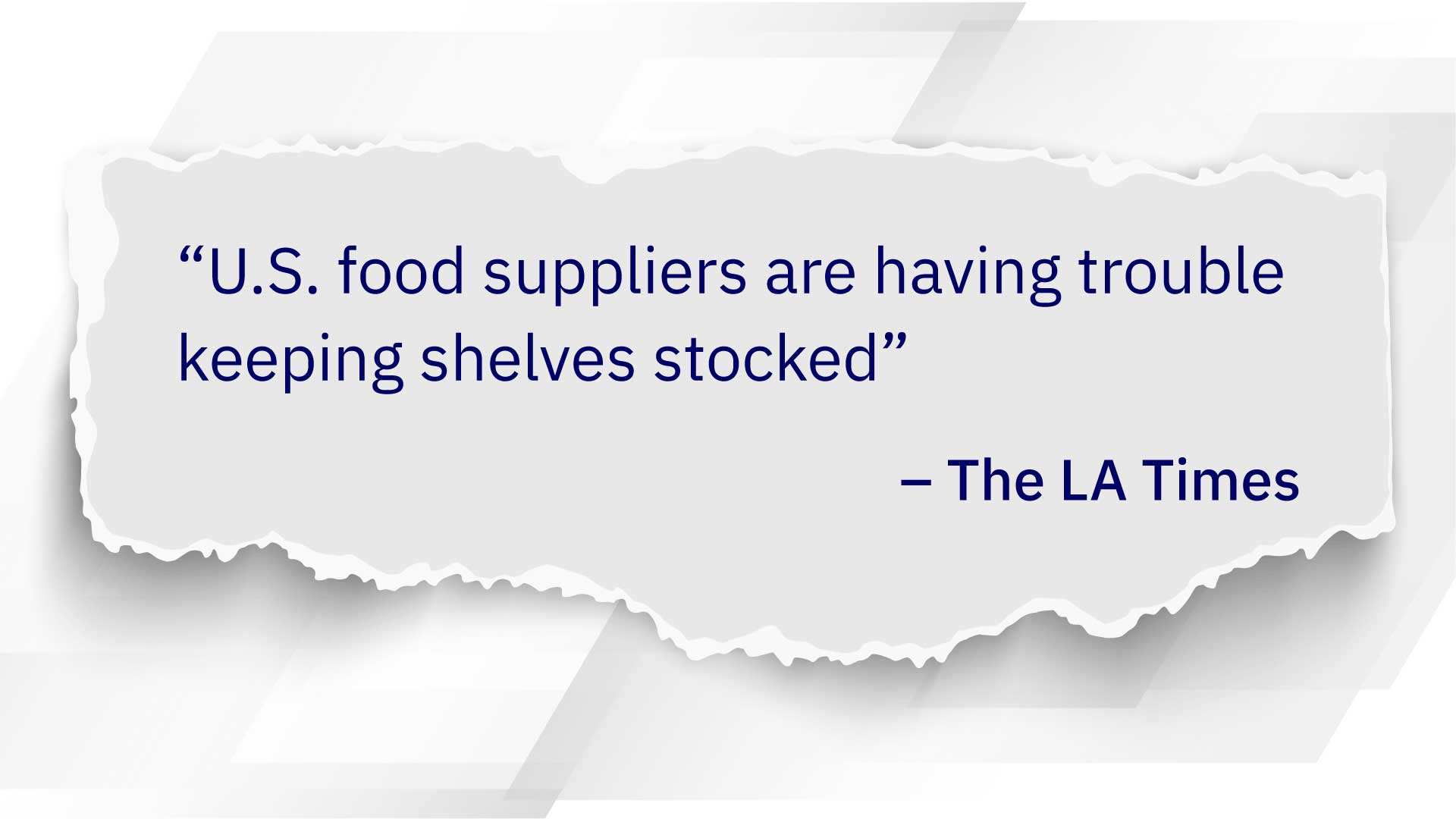
Not because of a recession or virus…
Not because of a new lockdown or war…
But the very opposite. A new threat which could soon cause empty shelves as far as the eye can see.
What exactly is going on?
If you’re an investor… if you own a home or business… if you are retired or plan to retire any time soon…
It’s important you pay close attention.
Because according to our guest today… the choices you make with your money—right now—will decide which side of this story you end up on.
As you’ll see…
The last time this happened… investors lost as much as 90% of their money.
While the few who knew what was happening and what to do…
They had the chance to make thirty times their money in a single year.
So what’s going on exactly? And how can you protect yourself—and profit?
Fortunately, we have just the man to help us figure it out.
One of The Most Trusted Tech Voices in America
Jeff Brown—thank you for being here.
JEFF: Thank you for having me, Chris. It’s great to be here.
CHRIS: Now folks if you haven’t met Jeff before… he’s one of the most trusted tech minds in America.
I’ve met dozens of distinguished guests throughout my career…
And I can say, unequivocally…
Jeff, you have made more big calls in the tech market than probably anyone.
I hope you don’t mind if I take a moment to share a bit of your story?
JEFF: That’s fine – go right ahead.
CHRIS: Jeff Brown is an angel investor—which means he backs early-stage tech startups. He’s done over two-hundred thirty deals in the world of private technology.
He was an early investor in America's largest cryptocurrency exchange, for example… Coinbase… years before it went public.
For decades he also worked as a senior executive at two of the top tech companies in the world.
And since 2015, he’s been sharing insights with a network of nearly 1.5 million readers.

He covered Tesla in 2018 when its stock was still trading at a split-adjusted $59—before it soared over 1,400%.
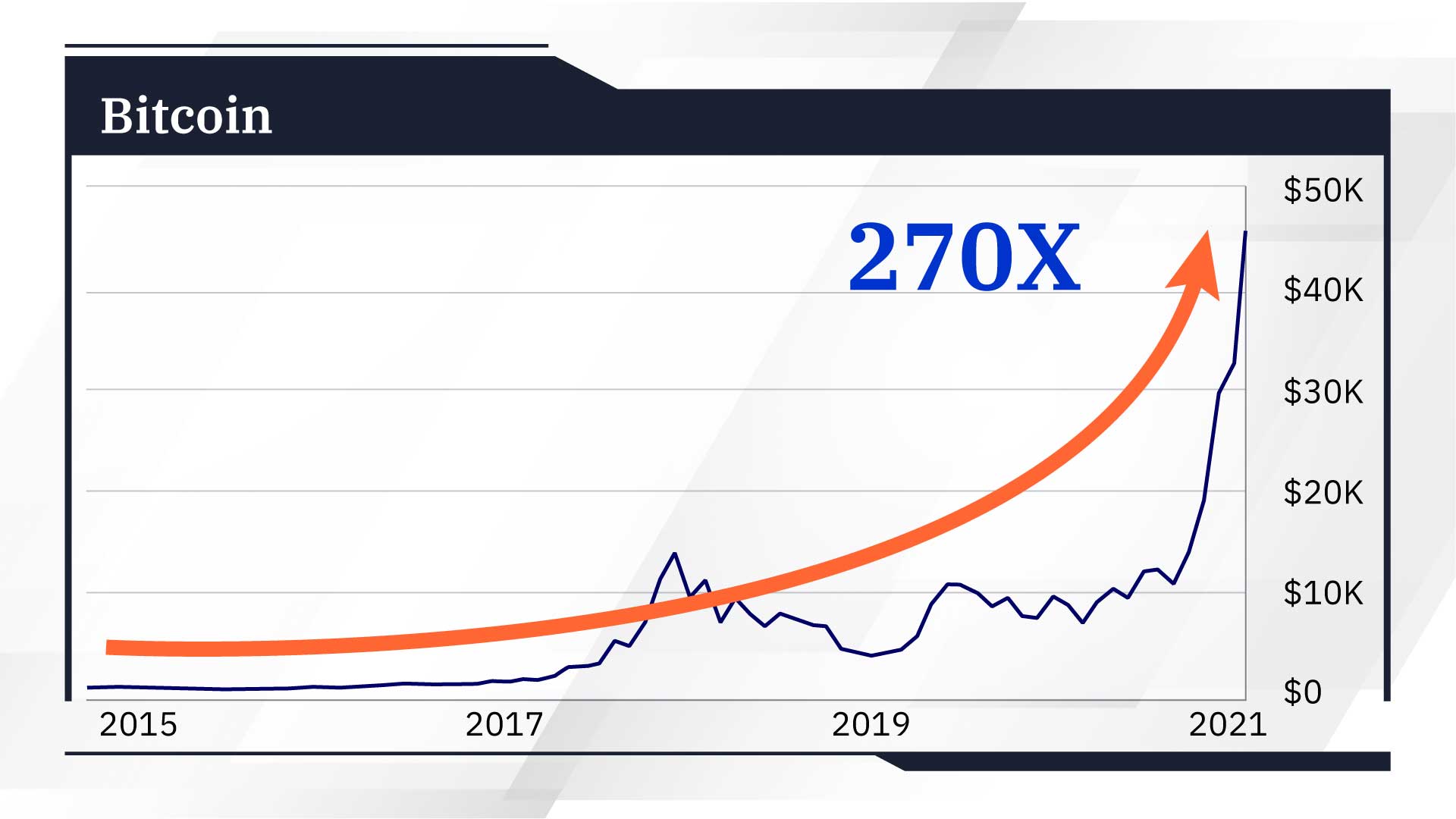
Jeff told anyone who would listen to buy Bitcoin when it was just $240. Folks who did? They had the chance to make 270 times their money.

Jeff was writing about 5G long before 5G phones even existed.

His firm predicted the dotcom crash in 2000… the housing bubble in 2008…
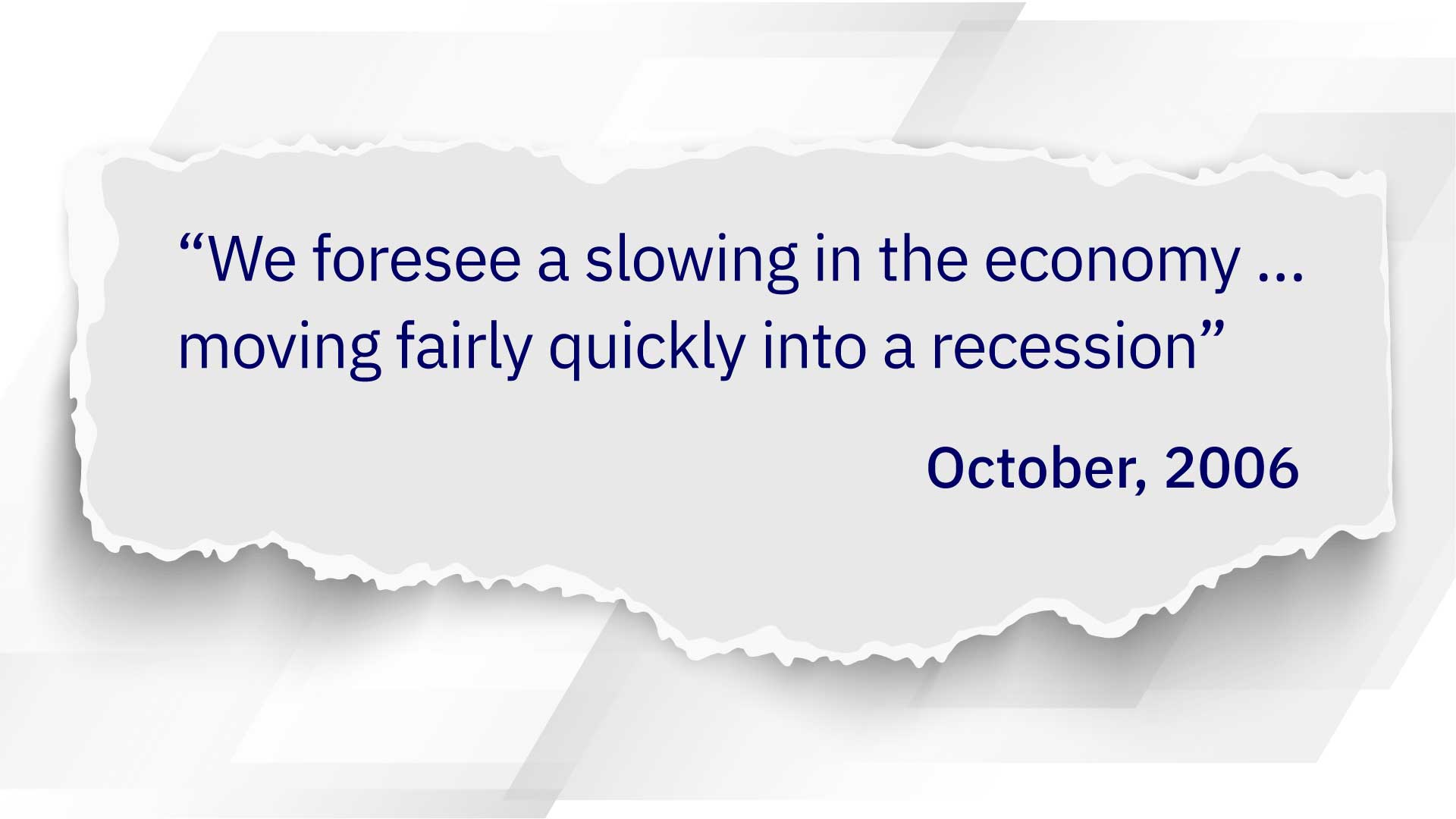

Jeff has served in our nation's capital as a member of the Chamber of Digital Commerce in Washington, DC.
Today he’s the founder and editor of one of the most widely read financial research firms in the world, Brownstone Research.
And we could not have him with us at a better time.
The World Is Going “Crazy”
Because our world is getting… crazy, Jeff. Is that fair to say?
JEFF: “Crazy” is one word for it, yes. That might be putting it lightly.
And for many people life is going to get much more strange in the weeks ahead.
For investors… as you say, it could be “very good”—if you know what’s happening and prepare. Or “very bad”—if you ignore it.
CHRIS: Given your track record—I’d encourage our viewers to pay close attention…
JEFF: Well I’m certainly proud of our work…
But let me make something clear.
The story I’d like to share with you today… it’s not a “prediction.” This is happening, as we speak.
The shortages we’re seeing today…
The soaring prices…

The sold-out signs…
To most people it makes no sense at all…
But as a former executive at companies like Qualcomm and NXP Semiconductors – I’ve seen it happen several times before… each with the same predictable result.
So I can tell you… with 100% certainty… what is happening. And what’s likely to happen next.
CHRIS: To be fair – it’s not just you. Even the President seems concerned about this….
JEFF: Sure… The President. Heads of state of many other countries too. Executives, researchers, news outlets. Everyone seems to agree.
The top tech firms in America all say this is “crucial to the technologies of today and tomorrow.”
Those are their exact words…
Which is why they just signed an urgent letter to Congress – practically begging them to do something, fast.
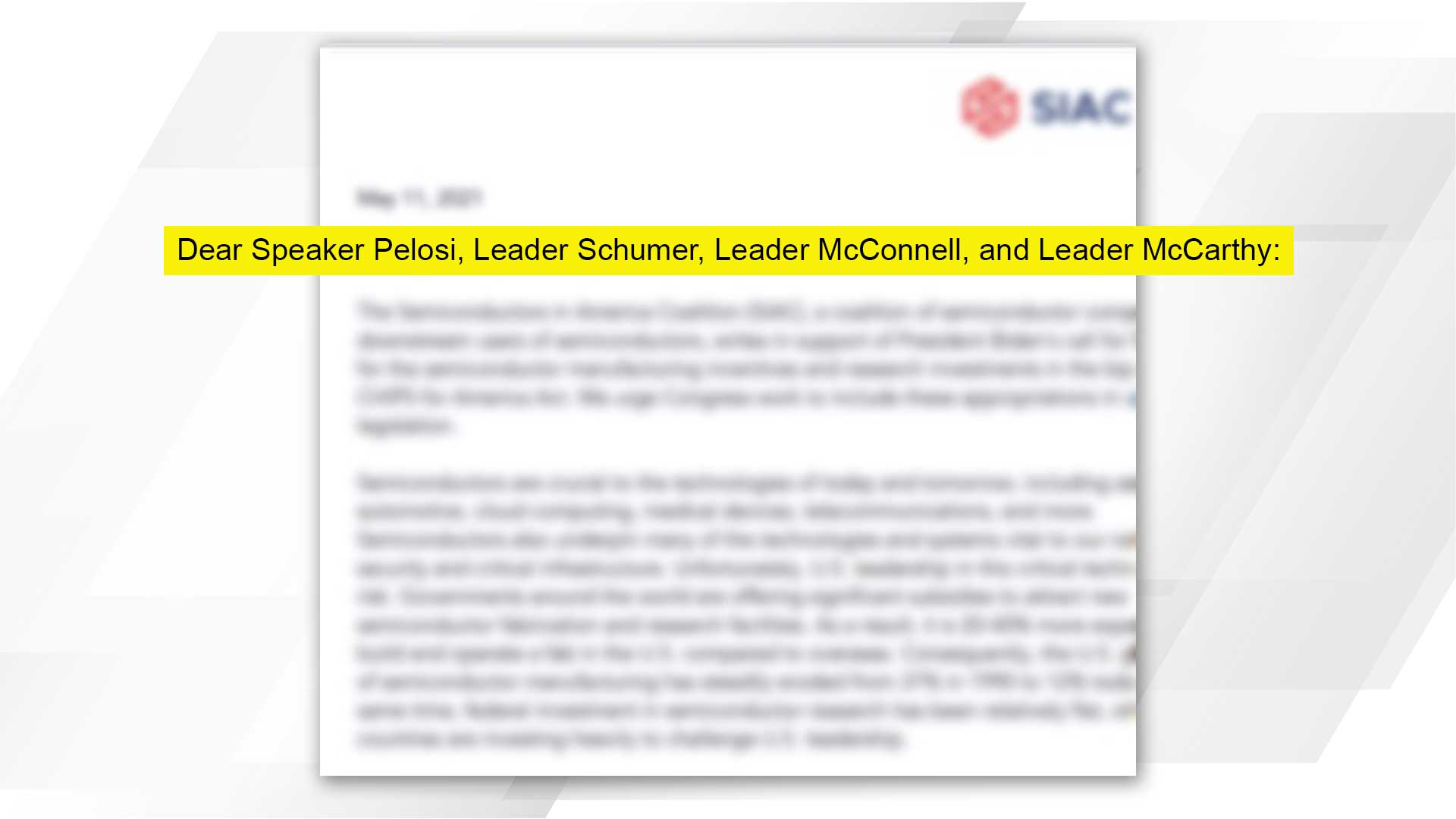
CHRIS: Wait… Every major tech company – all on the same page?
JEFF: That’s right. Every company that matters is on this list…
CHRIS: Amazon… Apple… General Electric… Google… Wow – I see what you’re saying. All household names.
But what are they all so worried about?
And how can our viewers at home put themselves on the right side of this crisis?
JEFF: For starters, we’ve got to be a little curious… we’ve got to start asking questions. And not just accepting what the media tells us.
Because the last time this happened… the result couldn’t have been more extreme.
Some investors made 30 times their money… while others LOST almost everything.
CHRIS: Seems like the stakes couldn’t be much higher. Where do we begin?
JEFF: The first step is to gain a simple understanding of what’s actually going on… and why it matters.
This alone will put you far ahead of the pack.
By the time we wrap up today, I promise…
You’ll see the signs around you. So when the rest of the world freaks out… You won’t panic. You’ll know precisely what’s happening and what it means for you.
Then…
Once you get the “big picture,” I’ll share what I think you should do with your money.
So what I’d like to do is show a few specific moves your viewers can make, today, to protect themselves and profit.
CHRIS: Folks if you’re coming in late—we’re talking with Jeff Brown today. This is a man who has served as a senior executive at two of the top tech firms in the world.
And now he’s here to share his next message.
He says a new crisis is rippling across the world. And history suggests… if you have money in the stock market, it could either bring you incredible wealth if you move today… or in a worst-case-scenario… you could lose everything.
Introducing: The “Tech Shock”
Now Jeff, you have a particular name for this event—you’re calling it a “Tech Shock.” And it’s something unique—it’s not the sort of event most of our viewers have seen before…
JEFF: Right–and for good reason. This has nothing to do with any pandemic or natural disaster. I am not talking about a shutdown or quarantine.

We really haven’t seen an event of this magnitude since the famous “Oil Shock” of the 1970s. Which – if you remember – was also a supply shock.
CHRIS: I was just a kid then – but yes… I do remember the huge lines to get gas for the car… and all the stations running dry.
So this Tech Shock that’s coming – you think it could be just as bad… or worse?
JEFF: Without a doubt, yes.
Because this crisis hinges on a single piece of technology that is critical to every electronic device we touch.
To most people, it’s not “obvious” like gasoline.
We won’t see lines of people waiting to get their hands on it… at least not yet.
Until now, it’s been largely “invisible” to the public. But that’s about to change in a hurry.
CHRIS: Invisible? How so?
JEFF: This technology is literally out of sight, out of mind. And yet, when you grasp its power – you’ll see it’s all around us. Every moment of every day.
Without it – our modern life would grind to a halt…
Dozens of entire INDUSTRIES depend on it.
From satellite communications… to concrete and steel manufacturing… to farm machinery to bitcoin mining.
But rather than explain what it is… how about I just show you?
I have it right here.
CHRIS: That would be great…
JEFF: I’m sure you’ve been wondering – what single piece of technology could matter SO much – it’s got the U.S. President… Apple Computer… plus major retail and grocery stores all in panic.
It’s this tiny square.

As you can see it’s no larger than the palm of my hand.
CHRIS: I see that.
JEFF: And though it may not look like much…
This single piece of technology controls… the entire world.
CHRIS: Wow… OK so what exactly are we looking at here??
JEFF: This thing right here on the tip of my finger…
It’s something called a “Semiconductor.” Otherwise known as a computer chip.
From the moment we wake up to the moment we fall asleep, this tiny tech is all around us—in any number of ways.
From your phone to your laptop… to your television and coffee pot… to your washing machine and even the oven…
And from tractors driven by the farmers growing your food… to the ventilators at your local hospital… to the missile detection systems monitored by Air Force personnel…
Every single one of those devices is controlled by this tiny piece of technology.
Get this…
There are 3,000 of them in a typical modern car.
Thousands more in the average fighter jet.
And as you may have noticed… there is one big problem.
CHRIS: What’s that?
JEFF: For all intents and purposes…we’ve run out of them.
I’m sure you’ve seen these headlines…

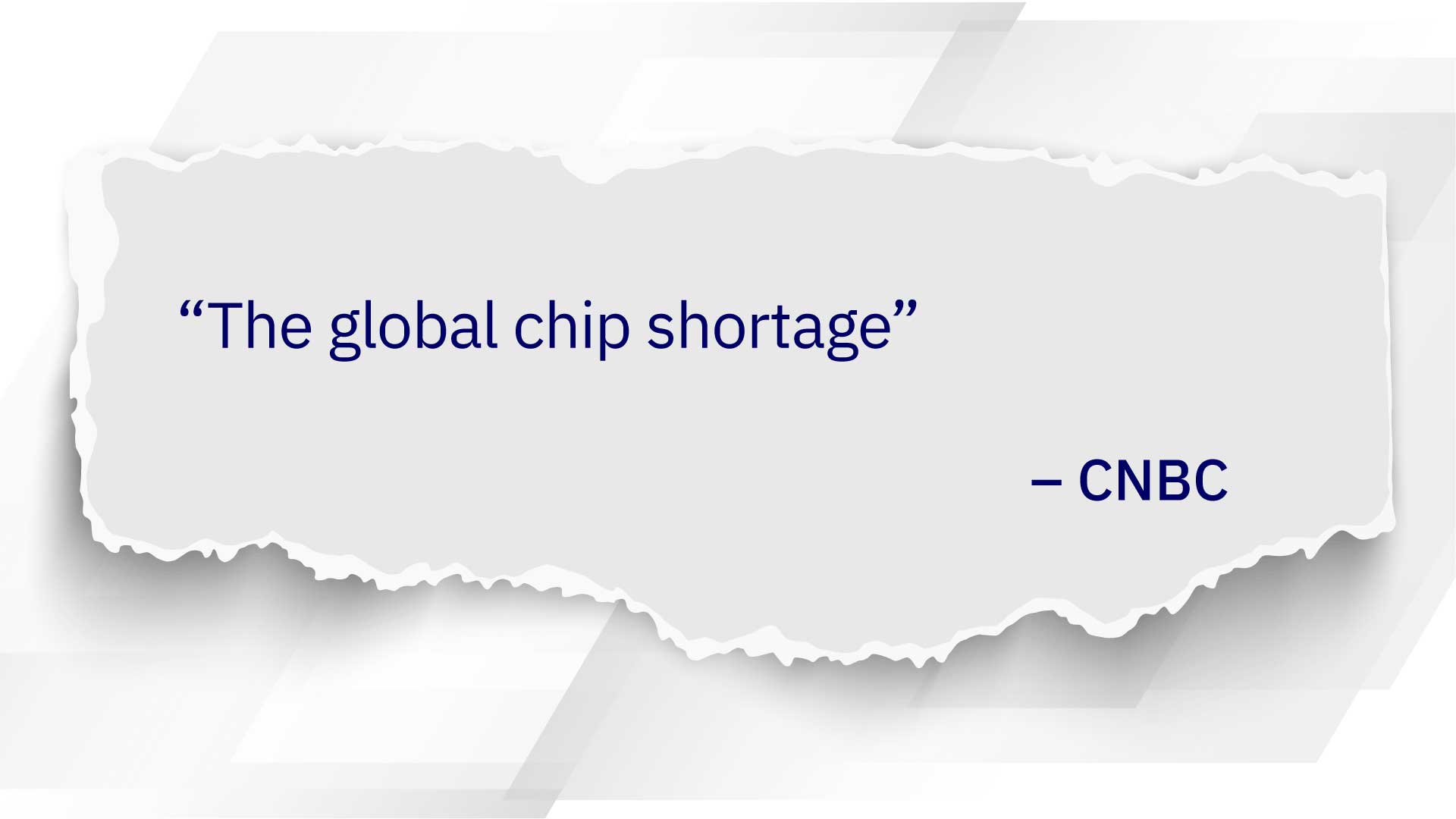
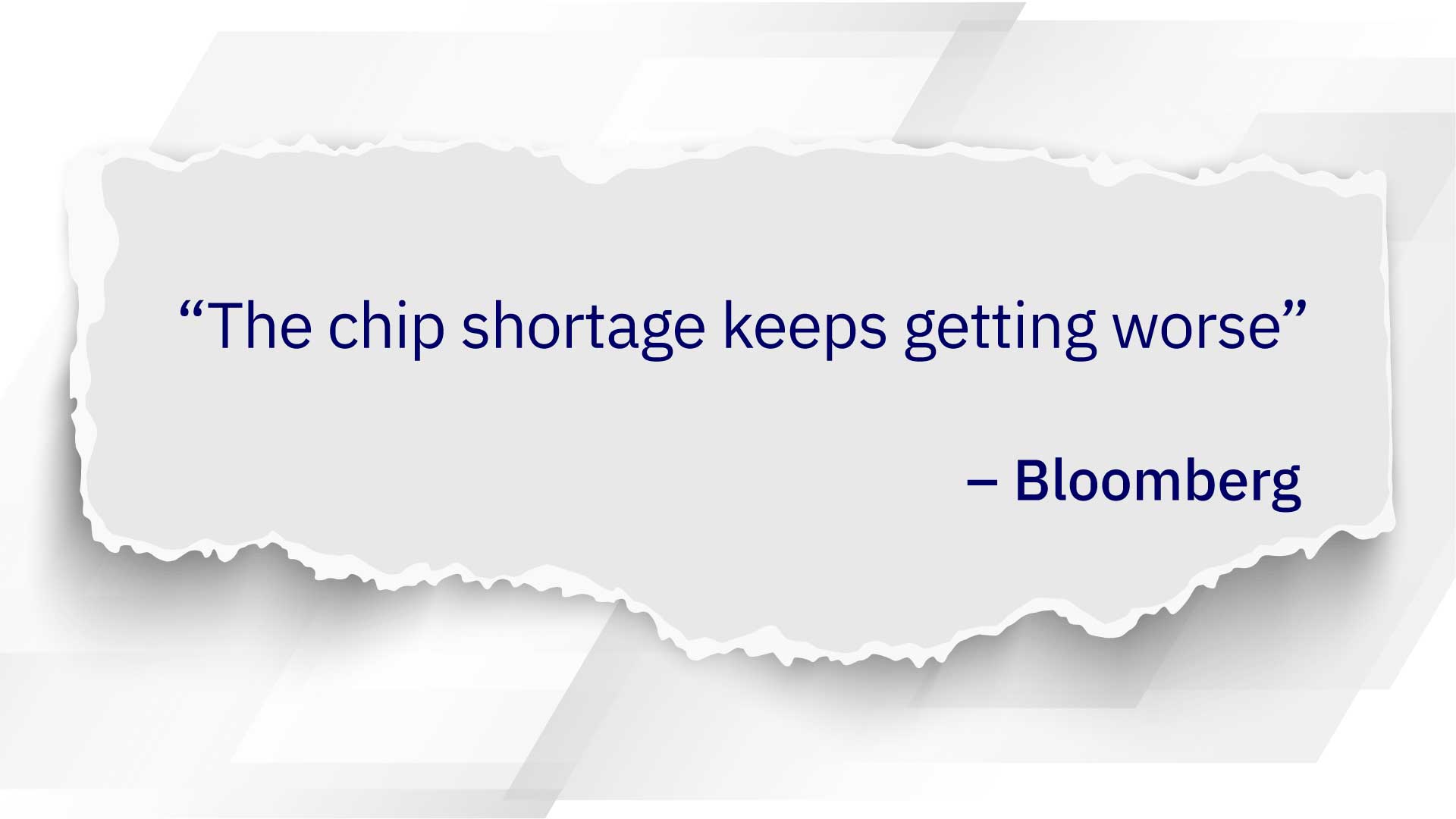



The Wall Street Journal, CNBC, Bloomberg, Forbes, Business Insider, The Harvard Business Review and every other major news outlet in the world… agree:
“We are in the midst of a global computer chip shortage.”
As The Guardian puts it, the global shortage of computer chips has reached a, “Crisis point.”

Intel says this shortage could last for, quote, “several years.”

CHRIS: So this “Tech Shock” is about computer chips. I’m starting to see where you’re going with this.
But where does the “shock” part come in, Jeff?
JEFF: We’re entering a kind of supply-shock – unlike anything we’ve seen before!
It may not be obvious to most people…
But the effects are popping up, everywhere.
The most obvious one is this: tech companies can’t produce enough consumer products to meet demand…
iPhones… tablets and laptops… XBoxes and PlayStation 5s… fridges, washing machines, alarm clocks…
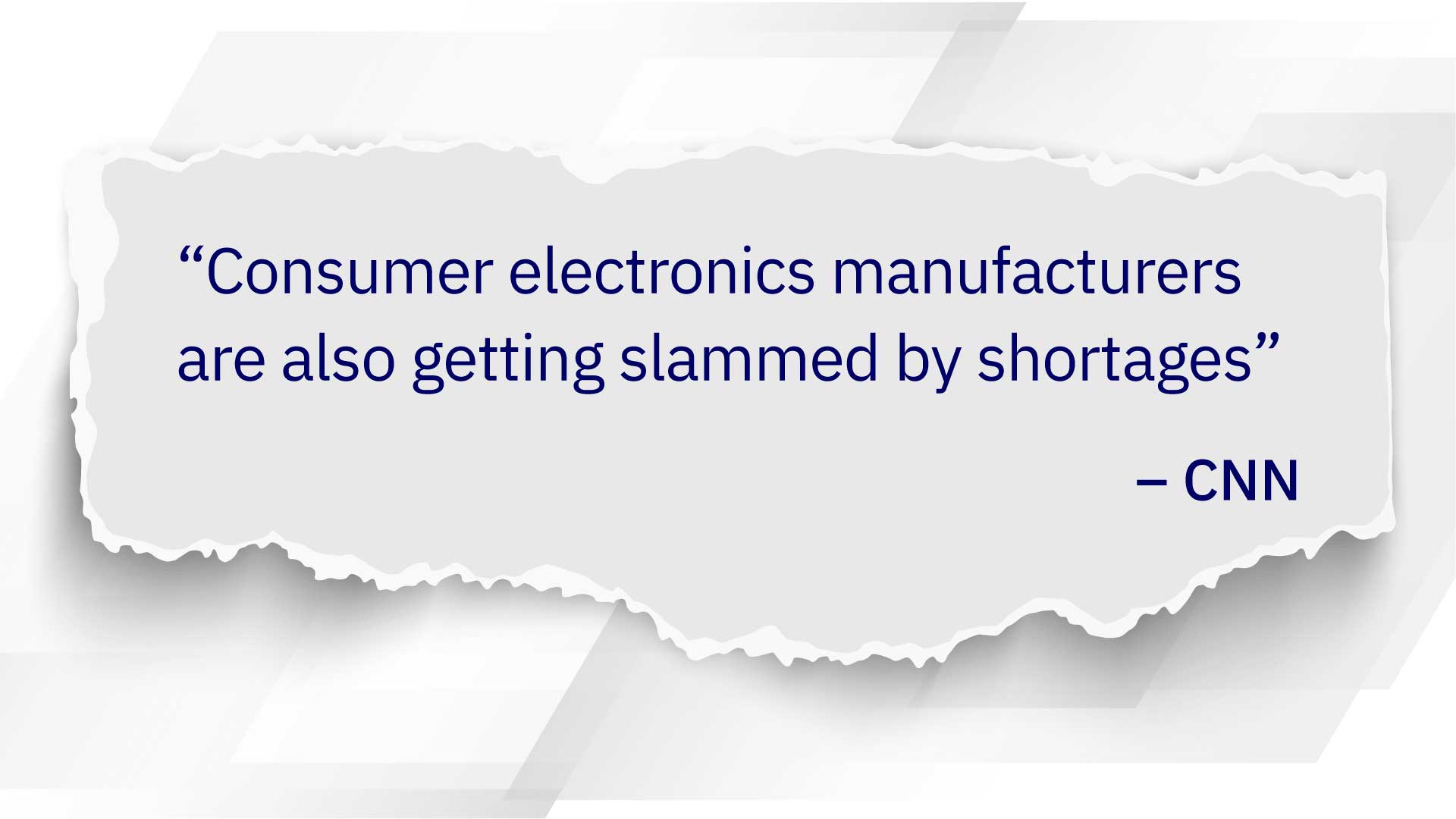
You name it, it’s getting harder to manufacture.
Which – for shoppers – means “harder to find” at the store And more expensive if you do find it. In large part because the largest semiconductor company in the world just jacked up prices by 20% – an unprecedented move.
CHRIS: Well – it’s no secret prices have been rising at the fastest pace in decades.
I think we’re all feeling the pinch, so to speak.
But you say it’s largely due to these “chips” which are in short supply.
That’s something I haven’t heard before.
JEFF: It’s everywhere… and unavoidable.
And you’re going to be hearing MUCH more about this in the weeks ahead.
Just recently, Tesla had to rewrite the code in its cars to reuse old chips, because they can’t find new ones. Their home solar power system, the Powerwall, is being slammed by this chip shortage too.

CHRIS: Wow…Tesla cars, the Powerwall… you have AI, EVs, and Solar Power—all being hit by this at once. I’m curious… How’s Elon Musk taking it?
JEFF: Not well at all…

He calls it Tesla’s biggest challenge… and says he’s never seen ANYTHING like it.
And that’s just one company.
Look at what’s happening to the traditional automotive industry…
Remember there are 3,000 of these chips in the typical car.
3,000 on average —and Chris, do you know how many of them need to be missing before production on a car is halted?
CHRIS: I’m not sure. Maybe one-hundred?
JEFF: One. The answer is one.
CHRIS: One? Wow.
JEFF: Making a car is much like baking a cake: you cannot bake the cake and add the eggs afterward.
If a car takes 3,000 chips—and you’re missing just one of them….
That car cannot be manufactured—the production line stops —until the company has every single chip.
CHRIS: So this explains why it’s hard to find a new pickup truck these days: GM, for example, had to shut down every single one of its pickup truck plants due to this chip shortage.
And car prices are “soaring,” as CNN puts it. Is this to do with the shortage and this production holdup?

JEFF: Yes… .
Imagine buying a car… driving it for a few years… and selling it for a profit?
Normally that’s impossible. I’ve never seen anything like that in my life before.
But thanks to the chip shortage – it’s become normal.
Used cars, in many cases, are selling for MORE than when they were new.

CHRIS: Which – sorry to interrupt – but that sounds crazy. Normally, you drive a new car off the lot, and it instantly loses value.
JEFF: It IS crazy… but when you understand what’s happening – it actually makes sense.
Used cars are more expensive because they’re ready… they’re running…
It’s simple supply and demand. Consumers want the cars – but there’s literally no new supply.
And for the big automakers…
This is catastrophic!
Ford’s profits were cut in half this year—in HALF–because they can’t assemble their vehicles.
It’s getting so bad…… you can see all their unfinished cars from space.
As Barron’s puts it, this shortage is “killing car stocks.”

CHRIS: OK… I get how this is hitting consumer tech… cars… but look…
Most people don’t have to buy a car very often…
And while I love my iPhone…
I’m not planning to upgrade anytime soon.
So I get that it’s a crisis for Ford and GM… and a headache for Tesla and Apple.
But why do you say it’s a crisis for the rest of us at this point?
JEFF: Look, Chris… I could sit here for hours and walk you through the entire ripple effect of a situation like this. But the simplest way to say it is this.
Without a sufficient supply of computer chips, the modern military does not exist. It does not even function.
Just about everything…
From the safety of our streets and homes—to the items stocked at our local grocery stores … to the millions of items filling Amazon’s warehouses–it all relies on the semiconductor… on the computer chip.
And unfortunately – we gave it all away.
CHRIS: Gave it away… to whom?
JEFF: To Asia… to places like South Korea and China and Singapore…
The vast majority of these chips are now produced overseas…
In fact, one company, based in Taiwan, produces 50% of them!

So here in the U.S. we’ve completely disbanded most of our chip production. It’s just about gone.
China gets this. Their government is pumping billions of dollars into local chip companies, to secure the interests of their country, their infrastructure, and their military.
The EU, South Korea… they’re doing the same thing.
And finally… so is the United States. As Vox writes, the White House is, “racing to expand chip manufacturing.”
But – it’s going to take YEARS.
You can’t just wave a magic wand and produce more of these chips overnight!
CHRIS: Did you say Taiwan… the island China is threatening to take over at any moment? They produce the majority of new computer chips?
JEFF: Yes… Can you imagine how dangerous this could be to our national security. And how difficult life would be if they “cut us off” so to speak.
Imagine not being able to replace your air conditioning in the middle of summer when it’s 100 degrees out.
Imagine your stovetop goes out and you have to microwave your food for six months.
You go to the hospital, and they have no cardiac equipment.
Chris, this would be a disaster of epic proportions. And not just for the U.S., but for the entire world.
I’m not going to say that this will happen…
Though it could.
But even if NOTHING goes wrong… this shortage we’re seeing today – it’s not a temporary inconvenience, or a passing trend…
It might drag on for years…
And it will ripple through our economy in surprising ways – catching most people off-guard.
I know one multi-millionaire who’s so concerned… he’s rented storage space. And he’s filling it with items that could become scarce in the weeks ahead.
For most people that’s not practical…
But it’s critical you pay attention.
The worst thing you can do at a time like this is “nothing.”
Get ready for a major “Tech Shock”—a deep and unexpected shortage of the modern economy’s lifeblood: computer chips.
The Real Truth About The Computer Chip Shortage
CHRIS: Well I have to tell you Jeff… I am glad we now understand the root of this crisis. But I don’t feel any better about it.
My impression is… It seems like we’re in big trouble…
And it could get much worse before it gets better.
But a moment ago – you mentioned how you lived through several chip shortages in the past. You worked at the heart of the chip-making world – in Asia.
And you were an executive… one of the decision makers at two top companies that make these chips.
So I’m wondering – could you share a bit more about what you learned on the inside and what might happen next?
JEFF: I did— I lived and worked in Asia for more than two decades. I’ve been to Taiwan… and Singapore both more than 100 times, working in the semiconductor industry for companies like Qualcomm and NXP Semiconductors. I also lived in San Diego and worked at the corporate headquarters of Qualcomm as well.
CHRIS: For reference, those are among the largest chipmakers in the entire world today.
JEFF: Speaking of Qualcomm—it was “ground zero” for the previous “Tech Shock”—back in 1999.
Now… what do you think about right away when I say “Tech in 1999”?
CHRIS: “Dotcom bubble.” And the crash that hit the next year.
JEFF: Right. That’s what most investors think about when they hear, “1999.”
But not me…
The “Tech Shock” of 1999
Chris… can you picture shares of Amazon, Facebook, or Google… collapsing 90%?
CHRIS: That’s hard to imagine.
JEFF: It’s almost unthinkable, right?
But when the last “Tech Shock” hit, in 1999, that’s exactly what happened.
Do you remember Motorola?
CHRIS: Right. The old cell phone company.
JEFF: Right. Most people know Motorola makes cell phones–and how they were one of the most prominent tech companies in the world.
But back in 1999… cell phones weren’t the most important part of Motorola’s business.
Their bread and butter was actually computer chips..
Including the G4 chip which powered Apple’s hot new computer.
At that time, Motorola was in an enviable position.
It was the sole supplier of chips for Apple.
But then, its deal fell through…
CHRIS: We don’t talk much about Motorola anymore… do we?
JEFF: Today… according to Forbes, Motorola is a “Shell of its former self.”

CNN is more blunt, writing, quote, “Motorola is dead.”

But if that deal with Apple had held… it might be a different story. Every iPhone and iPad today could have been powered by Motorola semiconductors…
CHRIS: Sounds like a major screw-up to me..
What happened there?
JEFF: Back in 1999, a massive chip shortage hit, much like what we’re seeing today.
If you paid attention to the headlines… you might have been tricked into believing it was a good thing.
Motorola officials said they were, “thrilled with the overwhelming and positive response.”
CHRIS: I would agree that sounds good for business–if you have more demand than you can fulfill.
JEFF: Well it’s better than selling nothing – that’s for sure.
But Steve Jobs and the rest of Apple Computer – they were furious.
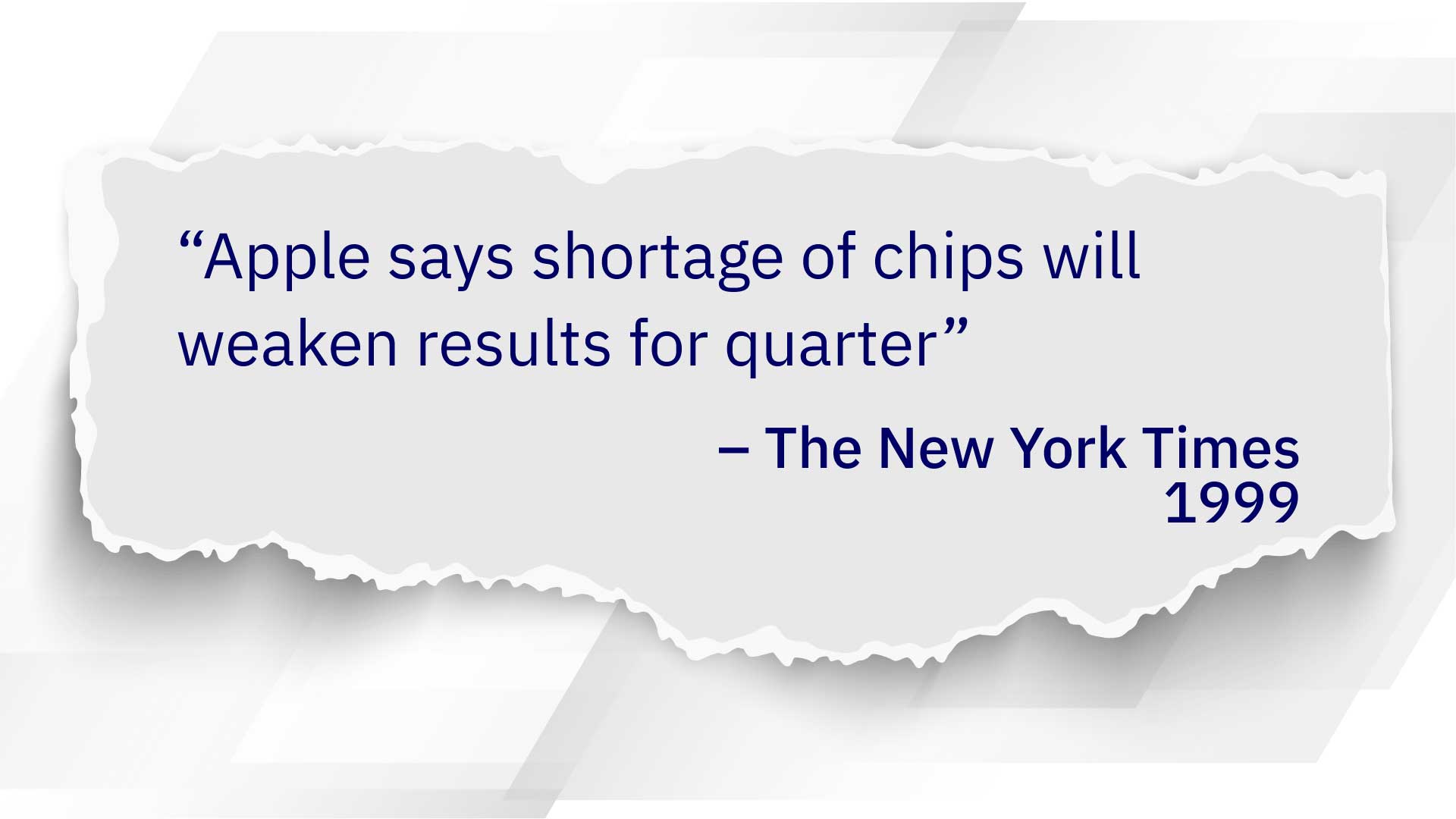
Jobs went so far as to call Motorola’s statement, “Crazy.”
Who could blame him? Apple received about 150,000 orders for their new G4 Mac, but could not build them without the chips from Motorola
And you can guess what happened next.
CHRIS: I’m thinking Apple must have started shopping around?
JEFF: Precisely… Apple reached out to dozens of other chip suppliers.
And slammed the door on Motorola – and its investors….
Long story short…
If you had purchased Motorola’s stock in 1999, at its peak…before it lost its exclusive deal with Apple…
You would have lost nearly every cent over the next few years.

CHRIS: All because of a chip shortage?
JEFF: All because of a chip shortage.
CHRIS: Yikes! So in other words. $10,000 in Motorola stock – when it appeared to be a “can’t miss” opportunity… would have only been worth about $700!
JEFF: Yes… like I said, investors lost 90% of their money.
Which brings us to today…
This year, the same story is playing out… Only now, the problem is much bigger, more widespread, and more destructive than what happened to Motorola in 1999.
And once again, it will surprise millions of investors.
That’s why I call this a “Shock.”
CHRIS: This doesn’t sound good.
JEFF: Well… before you get too worried, keep in mind—Motorola’s downfall, and the money investors could have lost, is just one half of the story.
The other half is the fortunes that ROSE from the “Tech Shock.”
The Upside of 1999
I saw it all happen.
Qualcomm not only survived the Tech Shock of ‘99, but thrived.
It went on to become a top Apple supplier … and it’s still one of the largest chip makers in the world today.
Take a look… if you bought Qualcomm in 1999 instead of Motorola, you could have made 30 times your money.
Not in 10 years…
Not in five years.
But in ONE single year.

CHRIS: Wow! So to recap, one group of investors LOST 90% of their money. While another group made 30-times their money?
Why such a huge difference?
JEFF: I’ve seen it happen over and over again…
The same thing happened in 1988.
The “Tech Shock” of 1988
The news from March of that year read:
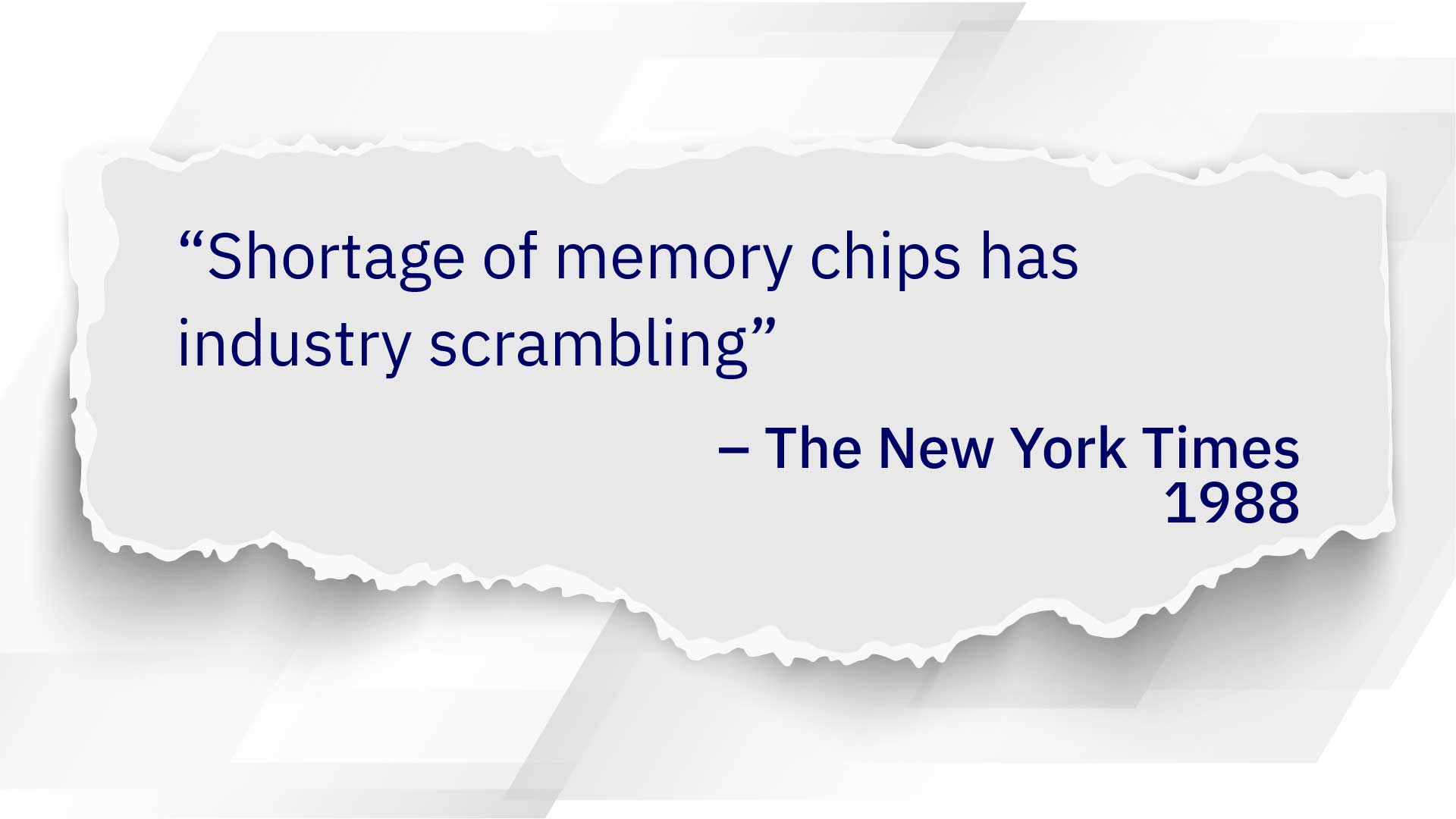
Due to a mass shortage… computer chip prices in America tripled in a matter of months.
Assembly lines were slowed. Product launches were delayed.
Consumers suddenly had to pay soaring prices for tech products.
CHRIS: Sounds like another “Tech Shock.”
JEFF: Yes similar to what we’re facing today. Of course this was the 1980s, when tech wasn’t such a big part of the market – or our lives.
But as you can see – the same pattern played out…
And the few companies that were ready for this—and adapted to it—saw tremendous results.
When I say “few,” I mean it. Only two companies in the entire country were still producing the most-needed chips by the time this shortage hit.
One was Micron Technology.
It used to be known by the mainstream press as, and I quote, “tiny.” That’s what the New York Times called it.
Until its stock went up over 3,700% thanks in large part to 1988’s “Tech Shock.”

The other firm was Texas Instruments— today worth over $170 billion. Its stock is up over 9,000%.

CHRIS: Okay—I’m starting to see a pattern here..
JEFF: Well I’m not done yet.
Let’s talk about 1984 and what happened to AMD.
The Rise of AMD
AMD–today it’s the world’s second largest maker of computer chips. Worth over $100 billion. Its biggest rival is Intel.
But back in 1984… it was tiny – just 1% of its current size.
CHRIS: But then let me guess. Then a “Tech Shock” rocked the market.
JEFF: Right. You’re catching on, Chris.
In 1984, Intel got, quote, “caught off guard” by chip demand…
And the tech world soon found itself in huge trouble.
Production of electronics fell…
Prices soared…
Companies were so desperate to secure a new supply of chips, they actually tried to bribe Intel to increase its production.

But Intel was maxed out. They couldn’t produce a single chip more.
All hope was lost.
Until…
AMD, this small company most hadn’t heard of before… stepped up and did something remarkable.
AMD started-get this- filling Intel’s orders for them.
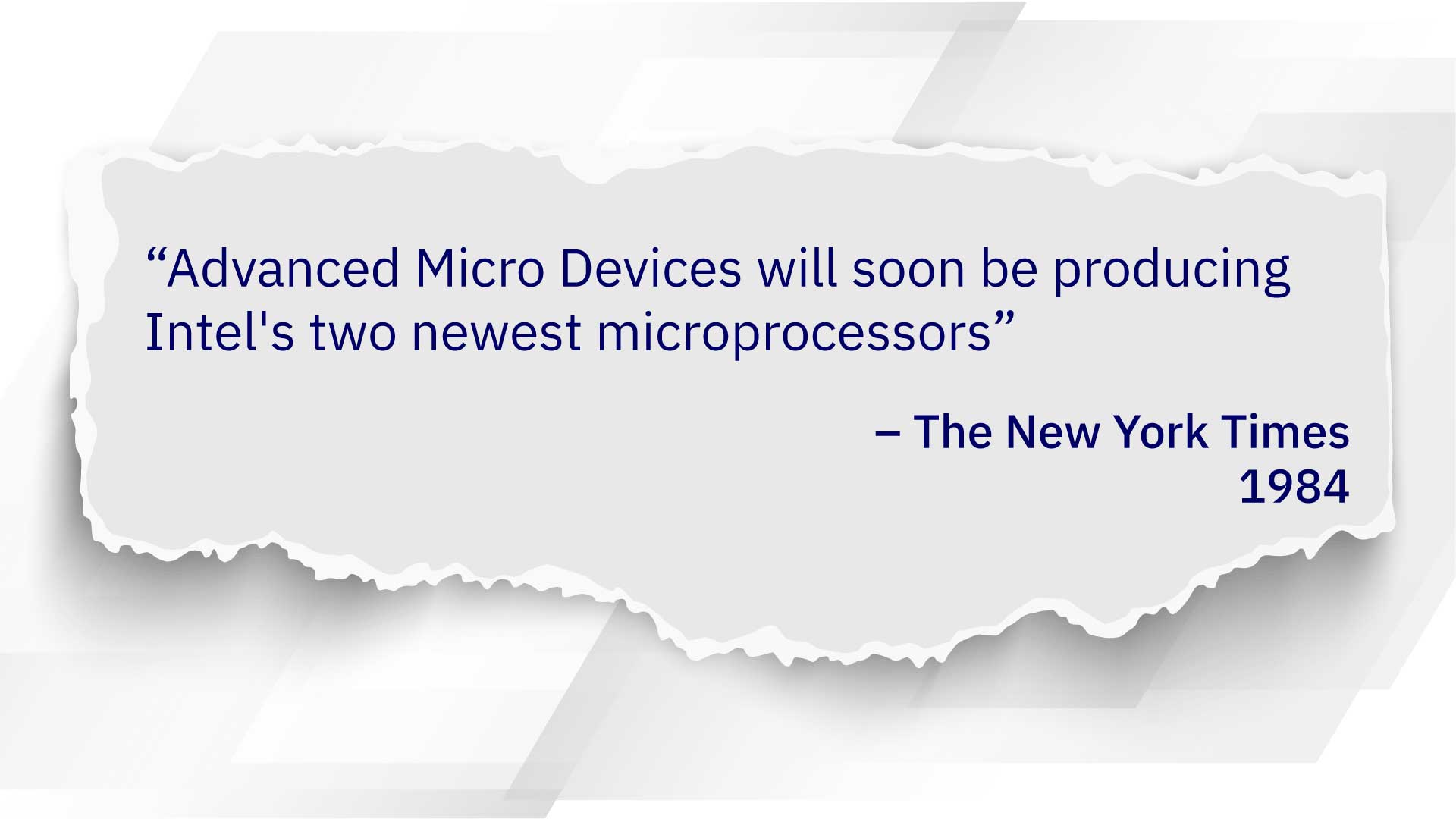
Can you imagine?
CHRIS: That’s as if some tiny vehicle startup were making Toyotas right now.
JEFF: It was insane. And frankly genius. Because number one, how could Intel refuse? And two, AMD was so successful at doing this, Chris… the “Tech Shock” of 1984 was over as soon as it started.
Before winter hit, the world went back to normal.

And today of course…

AMD is a nine-figure company.
Do you see what I mean?
CHRIS: I’m seeing it, yeah.
JEFF: This isn’t just about some one-off example from 1999. The examples keep going and going. We don’t have time to list all of them. But the big takeaway is this.
Every time a “Tech Shock” hits, it shakes the foundations of the tech world. It rewrites what we think we know. Small companies become big-big companies become small.
Today it’s happening again – with a twist.
Because this newest “Tech Shock” is bigger and faster and more severe than anything we have ever, ever seen.
This “Tech Shock” Is Far More Severe Than Any That Came Before
CHRIS: What makes you say that?
JEFF: First of all look around, Chris.
The signs are everywhere.
Unlike the 80s and 90s–when many homes didn’t even have a computer in them at all…
Computer chips are in just about everything now.
In fact, unlike in the 80s or 90s…
We are as reliant on them as electricity.
They’re in our toothbrushes now!
And it’s not just me saying this. In a 250-page document issued by our federal government on this exact topic…. they call computer chips, quote…
“Essential to modern day life.”
It’s easy to see why they say so…
Computers-and the chips they run on-are all over the place..
Think about this for a second…
You wake up first thing in the morning. What do you do?
CHRIS: Uh… maybe check my email… make a cup of coffee.
JEFF: Chips…
Then what?
CHRIS: I help get my kids ready… we hop in the car… I’ll head for work. Maybe listen to some satellite radio on the way.
JEFF: More chips!
I don’t mean to belabor the point… but just about everything you do relies on this tiny piece of technology.
When you check out a book at the library… or download an e-book.
When you fire up the TV and watch Netflix.
When you pop dinner into the oven or microwave.
When you do the laundry…
Or turn on the air conditioning…
When you do a FaceTime video call with grandma.
When you take a simple blood test at the doctor’s office…
Even when you buy a bag of chips from the store – or from a vending machine.
I think you get my point…
CHRIS: Sure… so even potato chips are powered by computer chips. It’s stunning when you think how far we’ve come… and how reliant we are on these little squares.
JEFF: And that’s just scratching the surface…
Consider the near-future…
The tech that’s coming next will make current demand look quaint in comparison..
CHRIS: I know. A few years ago I couldn’t have imagined cars driving themselves…
JEFF: And now self-driving cars are popping up everywhere. They’re poised to soon hit 30 million total on the road over the next decade.
CHRIS: It feels like the world moves so much faster now.
JEFF: Well if it feels like tech breakthroughs are happening faster these days, it’s because they are.
The computing power used by AI, Chris, jumped up 300,000 times just from 2012 to 2018…

You can see on that graph what appears to be a straight vertical line.
CHRIS: That’s incredible. It is… straight up!
JEFF: That is the kind of progress we’re now living through.
From 5G wireless to machine learning… to 3D printing… to advanced robotics… to cryptocurrency…
New technologies are transforming our world in ways we can barely comprehend—faster than we can possibly fathom.
And every single one of them relies thousands of computer chips to function.
If just ONE of those chips is in short supply – it’s a problem.
If many of them go missing for too long?
It all adds up to a tech shock unlike any we’ve seen before.
What’s Likely Coming Next
CHRIS: So would it be fair to say… this shortage isn’t ending any time soon? I mean, what happens now? What’s the next step, Jeff?
JEFF: As this chip shortage worsens in the days ahead…
I believe not only will car and consumer product shortages grow larger. Not only will soaring demand for tech put even more strain on the chip supply.
This is going to get much, much more painful for people who do not prepare now.
CHRIS: How do you mean?
JEFF: It’s bad enough to have a shortage of pickup trucks and car parts…
Imagine a mass shortage of Air Conditioning and heating units. Imagine your heater breaking down and no one can fix it—and no one can sell you another one.
Imagine what will happen as this hits medical devices, Chris. Ventilators. Scanners and EKG machines. Pacemakers.
Because that’s where this is headed.
Already the supply of new heaters and air conditioning units is strained.
Medical manufacturers like Philips are warning they will soon be forced to halt the production of devices used to treat cardiac arrest…

And as these chip companies have admitted…
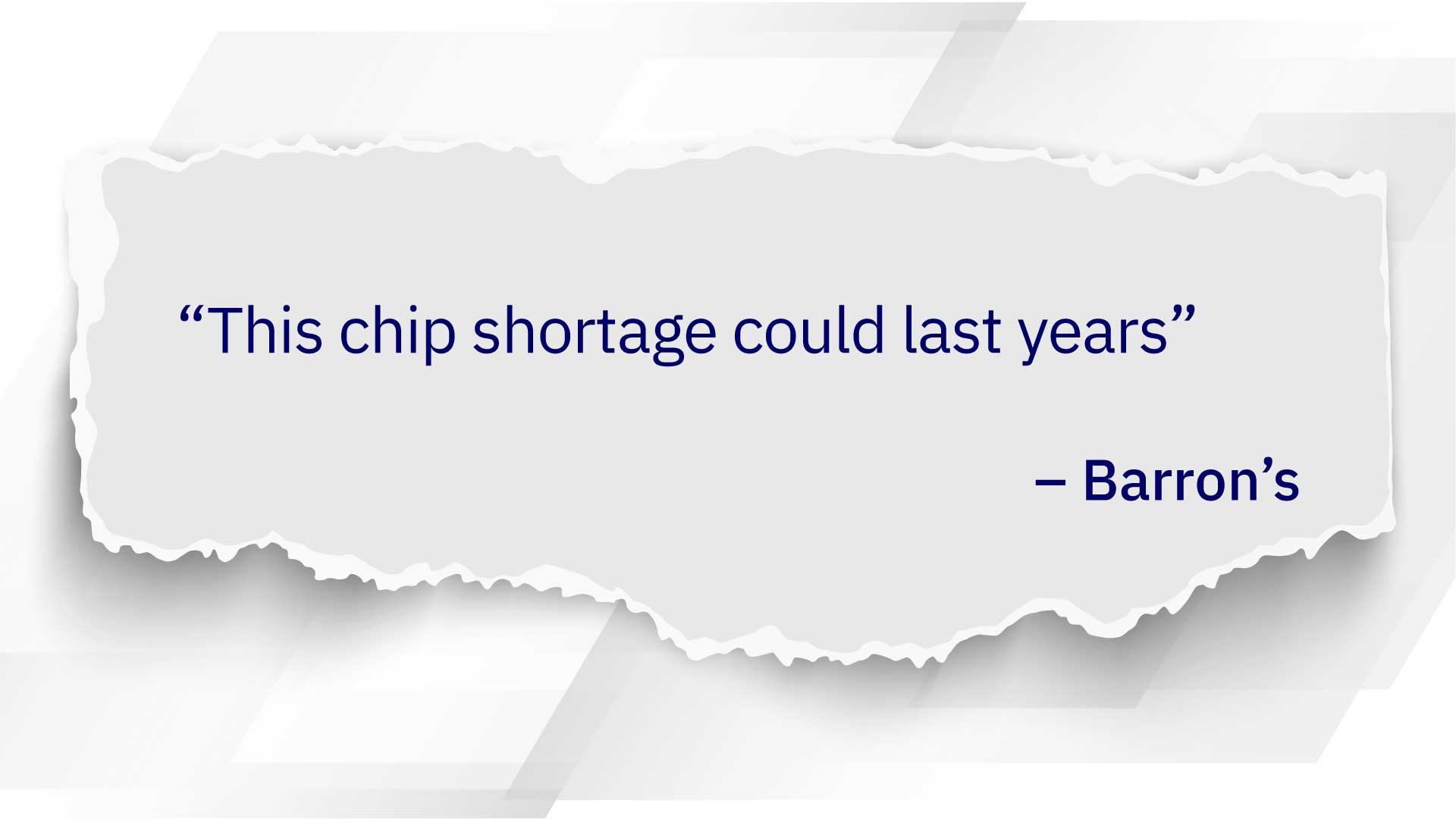
This shortage isn’t fleeting. This could last, best case scenario, for years. According to Intel, “several years.”

Look… this is real. It is serious.
CHRIS: Well, Jeff, I’m convinced. But what should someone watching right now do about this? What can we do right now to respond?
JEFF: Common sense solution? Look – if you need a laptop for work, maybe consider buying another as back-up.
Take 5 minutes… sit down with a pen and paper and ask yourself – “What electronic device could I NOT do without.”
And make sure you’re covered.
Because the way these shortages are appearing – you could be waiting months for a new device.
Or you could be forced to pay through the nose – if you need something ASAP.
Think about your household…
If your heater or AC unit is on its last legs, replace it right away..
If you’re thinking about getting a blood test? Do it as soon as possible.
And keep a close watch over your investments…
Because it goes without saying… you don’t want to risk losing your money.
CHRIS: Right… Like that 90% drop we saw with Motorola.
JEFF: Right… You do NOT want to repeat that experience.
So I’ve put all my research into an easy to follow report. So you know exactly what to do next. .
Step 1. The “Tech Shock” Portfolio
The first step…
Take a position in the companies poised to become the next generation of “Tech Shock” winners.
Remember, past “Tech Shocks” have delivered gains like…

875%…

2,900%…

3,700%…

Even over 9,000%…
In some cases in as little as one year.
Without the right research, you had nearly zero chance of finding these opportunities.
But for a brief time today, you have a chance to make the right moves.
Because as a former semiconductor executive, with years of experience identifying breakout investments in the stock and crypto markets, I’ve identified a select group of companies playing this “Tech Shock” in brilliant ways.
One of which Forbes calls “The Center of the Global Chip Shortage.” Why? Because it possesses a very special technology—and over 13,000 patents—that holds the key to solving this mess. I believe any company that wants to make bleeding edge computer chips—including the ones in this portfolio—must go through this company first. You’ve probably never even heard its name, but when this is all said and done, in my estimate, this company could go down in history as the one that saved the day…
And that’s just one of several companies in this portfolio. Which my research indicates are on the brink of an absolute explosion, just like what we’ve seen in the past…
I’ve written down their names and stock symbols in a special downloadable report, titled The “Tech Shock” Portfolio: Companies to Buy Now.

CHRIS: Now let me see if I have this right. You’re saying a single company could solve this thing?
JEFF: Essentially, yes. With the help of several other key players…
CHRIS: And you’ve written them all down for us.
Based on what’s happened before when companies get a “Tech Shock” right—2,000% gains… 3,000%… 9,000%—I think we all want to know. Where can we find that report, Jeff?
JEFF: I’m going to show everyone how they can get it in a moment. First let’s cover the next two steps you should take.
Step 2. The Companies to Stay Away From
Step two…
While past shocks created wealth for some, they destroyed it for others.
And sent the juggernaut Motorola, for example, plummeting by 90%.
Remember, Motorola survived the Tech Shocks of both 1984 and 1988.
That didn’t save it.
I want you to think about what it must have felt like, being a Motorola shareholder who bought in 99. Watching your money pile up into a substantial nest egg.
Then – all of a sudden… evaporate before your eyes.
Because I believe the same thing will happen again this time – with a twist.
Today, our world is a very different place than it was 20 years ago. And the damage of this latest “Tech Shock” is set to hit harder–and impact more people than ever before.
So you’re going to want to pay close attention to the names of the companies in this second report I’ve prepared, The “Tech Shock” Casualties: Companies to Avoid. And steer clear.
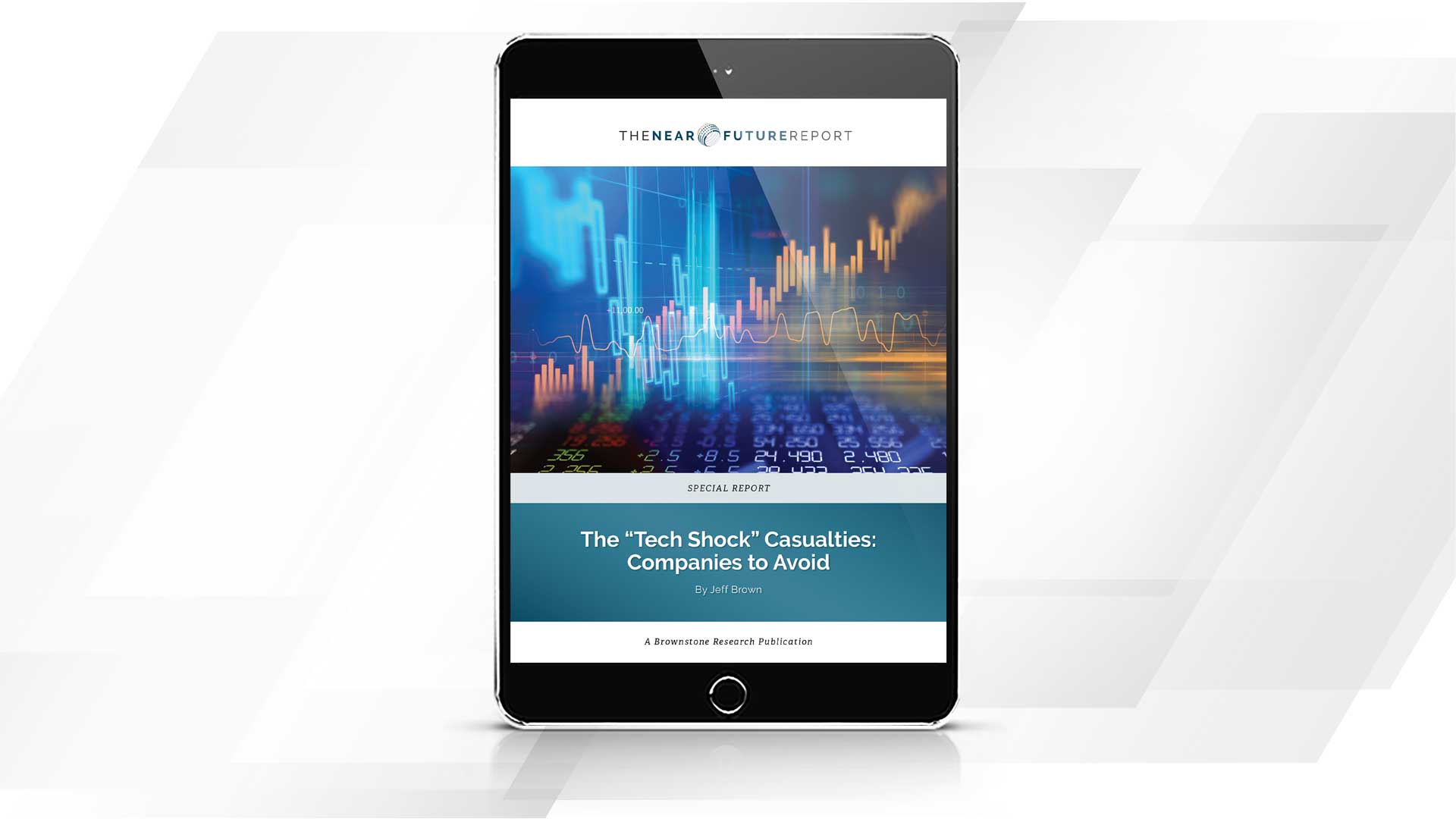
One of them is considered among the “safest” stocks on the market. You may very well own it right now. But let me be clear: I believe it is a ticking time bomb. And could be on the verge of being decimated by this “Tech Shock.”
I’ve written its name and a list of other companies to stay away from in this report.
CHRIS: Okay. We have the companies to buy, the companies to avoid. What’s next?
JEFF: Well that brings me to the final piece of research I’d like to share with you today…
Step 3. Profit from the “Stay Home” Surge
You see, as we speak…
There is another kind of shortage spreading right alongside the chip shortage. And it’s going to be a HUGE tailwind for the right tech stocks.
I’m talking about a labor shortage.
CHRIS: A labor shortage? I thought unemployment was the big concern—a jobs shortage. Not a worker shortage.
JEFF: We’ve rarely seen this happen before. But today… something very strange is going on in our labor market.
A lot of people are choosing to just “opt out” of it–to not work at all.
Despite employers doling out signing bonuses… and lavish benefits like pet insurance…
As CNBC reports, “There are about 1 million more job openings than people looking for work.”
CHRIS: How is that even possible?
JEFF: Whatever the reasons are behind this…
The key thing to understand is…
Millions of people are refusing to show up for work.
From hospitals… to retail… to restaurants.
And this “Great Resignation” as it’s called… is only fanning the flames of the chip shortage.
Think about it…
Say you own a fast food restaurant.
And you can’t find help.
What are you going to do?
Just give up… and go home?
If you want to stay in business?
You have one real choice.
Automation.
CHRIS: Which is to say… computers doing the jobs that people won’t do?
JEFF: Right. You may have noticed these “order kiosks” springing up across the country. This one is at a nearby McDonald’s.

They take the place of cashiers… And people tend to like them even more – because they get every order right.
And in the kitchen – we’re seeing new automation technology rolled out to replace burger flippers.
CHRIS:A.I. in the kitchen? That’s incredible.
JEFF:One example is a burger flipping robot, called “Flippy.”
It’s being tested at key locations across the country.
And this tech or something like it will quickly take over the fast food industry.
It never calls in sick. It’s never late. It never has issues with Human Resources. And it works around the clock… for just $3 per hour.

And what do these devices need in order to operate?
CHRIS: Chips.
JEFF: So with the advancement of AI and computing speed… with one million unfilled positions in our labor market—and I expect that number will only grow larger from here… what will happen is those human workers in menial jobs will soon be replaced by robots. By the chips that run those robots.
Whether it’s fully automated “robotic farms” powered by drones and sensors…

“Machine vision” replacing assembly line workers…

Or AI discovering medicines all on its own–to the point that even biology PhDs are now being warned to “get to grips with what AI can do”—and consider new lines of work…

CHRIS: Even PhDs are being automated… nothing is safe anymore.
JEFF: Even PhDs, Chris.
This mass automation of labor is ramping up much faster than most realize.
And it is set to drive computer chip demand even higher. And investors who position themselves in the right companies today could make a fortune. That’s why I’ve prepared a portfolio of companies I consider the very top players in this space.
You’ll find everything inside a third research report, titled The Age of Automation.

CHRIS: So there we have it. Three steps, those three reports. Jeff, I’m sure a lot of our viewers are wondering how they can get access to all this fantastic research—the potential tech shock winners, the potential losers, and the companies leading the way on automation you just mentioned?
JEFF: Well the good news is, they can get all three of these reports right now, for free. Just by trying out my newsletter called, The Near Future Report.
The Near Future Report
CHRIS: So for anyone who hasn’t heard about this–can you tell us a bit more about The Near Future Report–what it is, how it works?
JEFF: Sure, Chris.
The Near Future Report is my flagship financial research service.
I created it because, as we’ve discussed here, technology today moves faster than most people can keep up with.
If you’ve ever wondered if the playing field was “tilted” toward Wall Street…
I can tell you 100%, those suspicious are correct.
The kind of information I have access to is far beyond what the average person sees in the mainstream press.
In the past…
By the time you’d hear about a major tech trend, it was just too late!
The market already shot up. The profits were gone. And only insiders like me had a chance to profit…
That’s where The Near Future Report comes in.
Every month, I publish a new issue.
And I explain what’s going on at the bleeding edge of the tech world—and then identify one or more companies set to profit from it.
So you get a chance to hear about, and invest in, the biggest tech trends. Long before the average person hears about them.
CHRIS: I know you recommended Bitcoin when it was just $240. Six years before Wall Street banks started buying it… giving your readers the chance at 270 times their money.

And looking at your record…
You were one of the first analysts in the world to cover 5G.
You’ve recommended the #1 returning tech stock of 2016, 2018, 2019, and 2020.

You picked another chip company… NVIDIA in 2016… and it’s since exploded as high as 3,558%.
Enough to turn every $10,000 into over $340,000.
And this is incredible.
Looking into your model portfolio… as of late August, every single one of your 5G, AI, and cryptocurrency picks is up. Out of 19 positions, they are all winners. And not small winners—some are already up as high as 400%… 500%… 600% as we speak.
JEFF: Thanks, Chris. I’m very proud of the success we’ve had—and continue to have.
What Jeff’s Readers Have to Say
CHRIS: We requested access to your “feedback” from readers…
And I have to say, I’m impressed. Most of them who took the time to write in are thrilled.
Like when Daniel wrote in and said,

Or Nader, who told us…

Or Joel…
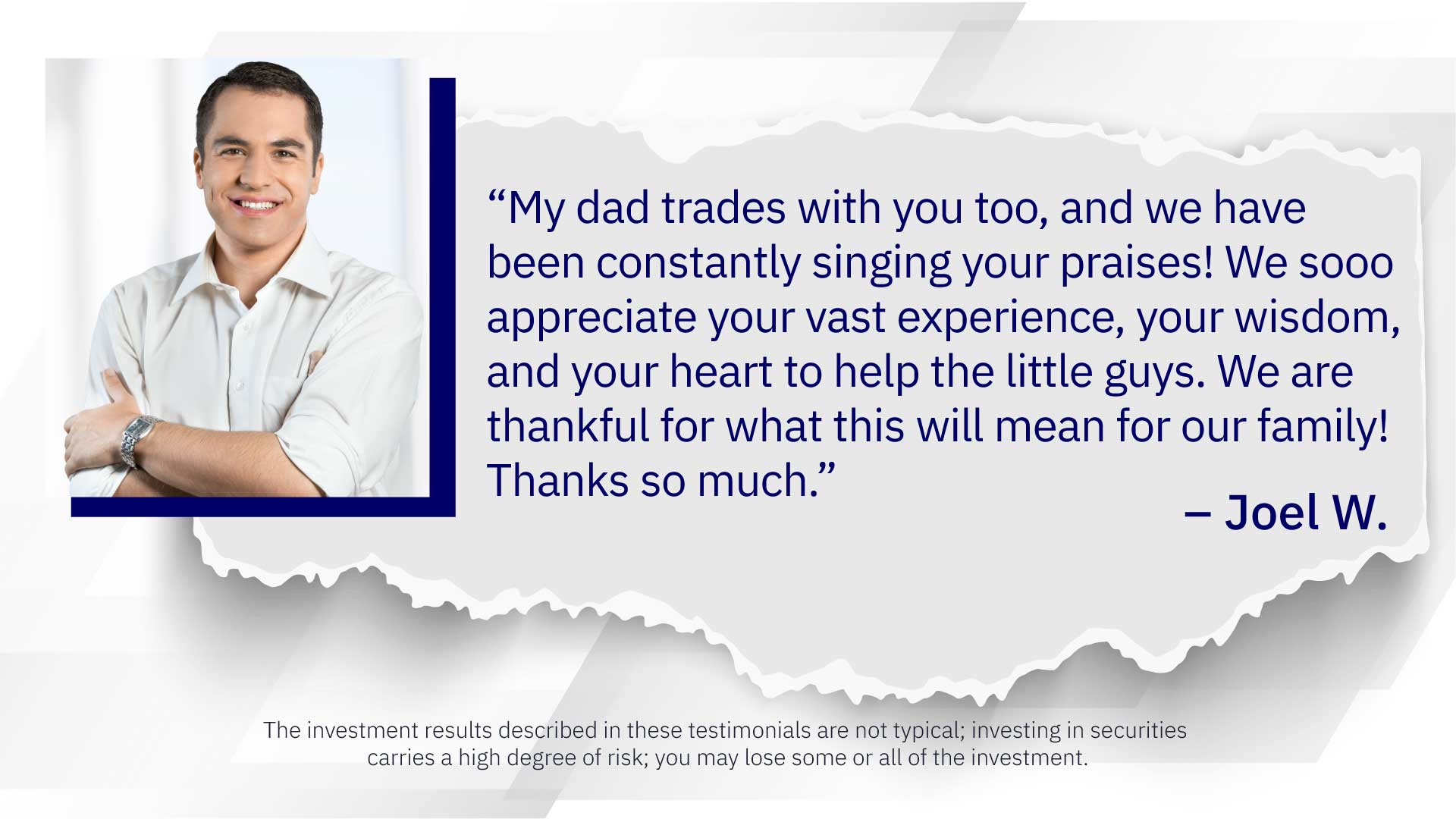
JEFF:
I’m proud to say that many of my readers believe so strongly in my research that they’ve signed up as Lifetime members of The Near Future Report—and as Lifetime members, they’re able to pass their subscription down to their heirs. So I’m not just working for them, but for their families too.
CHRIS: Jeff, this sounds great. How much does something like this cost?
JEFF: Well on Wall Street, this sort of research can cost well into the hundreds of thousands of dollars per year.
But I’ve been fortunate—I’ve made my money. I don’t need or want you to pay me hundreds of thousands of dollars.
What I like to do, instead, is to “crowd-source” my research.
So instead of charging a five or six figure sum to a handful of major clients – I work with tens of thousands of people… which brings the price down to a much more reasonable level.
The typical price for all my analysis and every recommendation in The Near Future Report—is just $199 per year.
CHRIS: That’s a lot lower than I was expecting.
JEFF: And sometimes, when I see a truly transformative opportunity like this…
I like to go one better.
So today… for folks watching now… I’ve worked out a deal with my publisher.
CHRIS: Ok – I’m just looking this over.

Ok – I’m just looking this over.
And Jeff…
Wow – you’re not kidding.
This is beyond generous.
OK folks. So I have received confirmation when you try Jeff’s research today…
You won’t pay $199 to join… or $100… not even $75.
Instead, when you order through the special link you’ll see beneath this presentation, you’ll pay just $49 for an entire year of The Near Future Report. 12 issues, all Jeff’s monthly analysis. And, of course, all three of your special reports.
JEFF: And I want to point out, Chris…
You can try The Near Future Report at my risk, not yours.
Your purchase is backed by my 60-day, 100% money back guarantee. You can check out my research for 60 full days. If it’s not for you, call up my Florida-based team. And they’ll issue a full refund.
CHRIS: Wow… Let me recap all that.
So folks who respond today are in for a real treat.
Instead of the typical $199 price – they’re getting in for just $49.
They’re getting all your research on the Tech Shock — including the three reports you mentioned:
That would be:
The “Tech Shock” Portfolio, The “Tech Shock” Casualties, and The Age of Automation…
Plus access to your monthly research letter, The Near Future Report.
And you’re saying all this is covered by a 60-day, money back guarantee?
JEFF: That’s right…
But Chris, you left one important thing out.
CHRIS: What’s that?
JEFF: The trend I shared with you today… it’s just one of several I’m covering in The Near Future Report.
A Full Library of the World’s Most Important Financial Research
So for folks who sign up today — they’re also going to get full access to my complete library of back-issues and special reports.
Including:
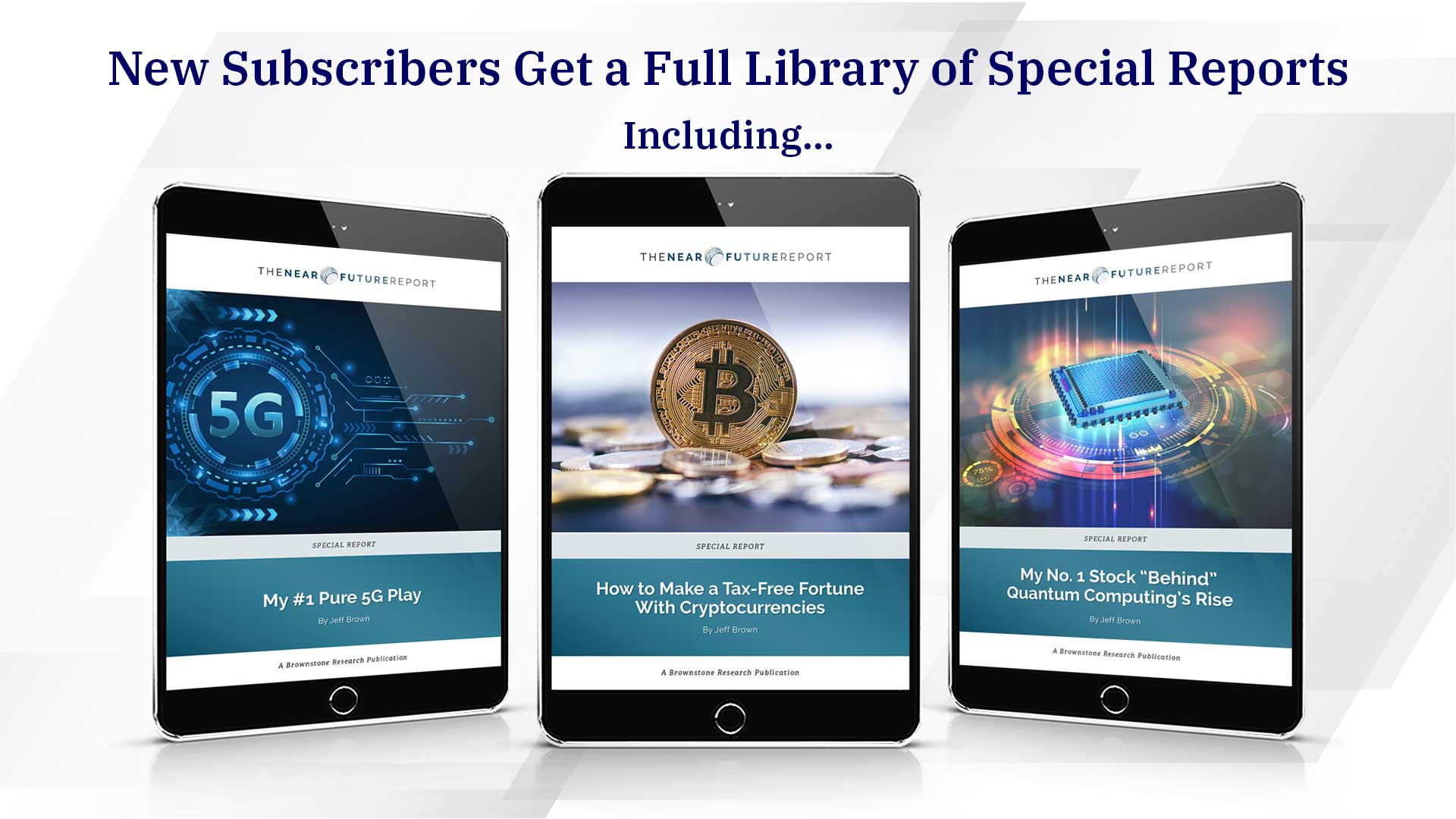
How to make a tax-free fortune from cryptocurrencies…
And The #1 Stock “Behind” Quantum Computing.
These are all yours, free, as soon as you join The Near Future Report.
Along with full access to our model portfolio.
My goal is to make it as simple as possible for you to follow along each month. So we put every single buy, sell and hold recommendation into a portfolio. That’s where we track performance and update you when it’s time to buy… or take profits.
CHRIS: Well Jeff, this sounds like a remarkable offer to me. How can folks at home join The Near Future Report?
JEFF: All you need to do is click the button you see on your screen. That will take you to our sign up page where you can review everything we’ve discussed so far—and secure your membership.
In Summary
CHRIS: So folks, to repeat…
Jeff is offering us all this.

Everything you see on your screen right here.
And it’s just $49—if you order right now.
And normally this costs much more, is that right?
JEFF: Correct. On my publisher’s website, The Near Future Report costs $199 per year. But if you click the button below, you’ll get instant access for only $49.
CHRIS: So everyone, again… you can access Jeff’s offer by clicking the button you see on your screen now. That will take you over to a secure order form where you can claim your special 75% discount.
Now I hate to say it, but we’re running out of time here.
Jeff – it’s been a pleasure to have you on the program again.
Before we sign off… is there anything else you’d like to add?
JEFF: Yes, Chris. There is one more thing I’d like to say. If you don’t mind I’m going to speak directly to everyone at home.
You Now Face a Choice

Folks…
You have a choice in front of you right now.
A choice that every American will face soon—whether they realize it or not.
Option one is…
You can ignore what you’re seeing in the news. You can ignore what you’re seeing all across the country, all across the world. You can ignore everything you’ve seen here today in this video, and walk away.
You can hope there will be no consequences for all this. That there will be no lasting effects caused by what may soon be known as the worst supply crisis in human history.
But frankly…
I’ve been doing this for more than thirty years.
And I can tell you—having seen this story play out over and over again—though never as bad as today…
All the hoping and wishing in the world will not make this crisis go away. It will not make it any easier when this “Tech Shock” comes for you… for your family… and for your wealth.
It will not bring your money back. It will not give you a second chance.
Fortunately—you do have another option.
Option two…
The option to act. To do what needs to be done to sidestep the worst of this… and make the moves that have, in the past, multiplied investors’ money by as much as 30… 40… even 90 times.
You can act alone—you can try to navigate this yourself. You can spend 40 hours per week researching and planning, and countless hours more implementing your strategy.
Or, for what amounts to less than 14 cents per day… you can leave that work to me. You join me, my staff of analysts and researchers… and my community of over one million successful readers—who know and trust that I will do everything in my power to keep them safe.
The choice is ultimately yours.
But you risk nothing by taking a look at my research right now. You have a full 60 days to look it over—and you get every dime back on your subscription if you don’t like it.
You have nothing to lose here.
And if I’m right… you have everything to gain.
I hope I’ll see you soon in The Near Future Report.
Thank you for listening—thank you for your time —and Chris, thank you for inviting me here today.
CHRIS: Jeff, it has been an honor having you with us. I cannot thank you enough for bringing this message to our viewers. This is far more serious than I could have imagined.
I know as soon as we’re done here, the first thing I’m going to do is page through your research.
Final Thoughts From Chris

Now if you’re at home and you want to do the same thing, you can access all of Jeff’s research, including three special reports on “The Tech Shock”…
The “Tech Shock” Portfolio, The “Tech Shock” Casualties, and The Age of Automation…
Plus a full suite of extra bonuses including Jeff’s #1 Pure 5G Play, How to make a tax free fortune with cryptocurrencies, and The #1 Stock “Behind” Quantum Computing’s Rise…
And of course, a full year of membership to The Near Future Report, Jeff’s flagship research service…
All for a record-low price.
You’ll get all of this, and more, at a 75% discount—just $49—by clicking the button on your screen now.

My advice?
Do it. Go ahead. Click that button—and get yourself in position for this “Tech Shock.” Don’t wait.
Do this right now—so you’re ready… no matter what comes next.
Thank you all for watching.
I’m Chris Hurt.
September 2021
© 2021 Brownstone Research. All Rights Reserved.


